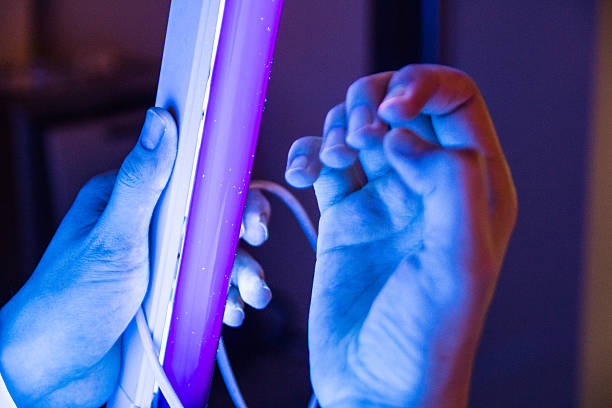
The Difference Between UVA and UVB Light: What You Need to Know for Psoriasis and Eczema Care
Share
Managing chronic skin conditions like psoriasis and eczema often involves a combination of treatments. Among the most effective non-invasive therapies is light therapy, also known as phototherapy. However, many people are unsure about the difference between UVA and UVB light, and more importantly, which one actually helps with skin conditions.
At Australian Psoriasis and Eczema Supplies, we specialise in products that support effective home treatments, including UVB light therapy lamps. This article explains the difference between UVA and UVB light, their roles in skin health, and why UVB is the recommended option for managing psoriasis and eczema.
Understanding Light Therapy
What is Phototherapy?
Phototherapy is a treatment that uses specific wavelengths of ultraviolet (UV) light to reduce inflammation, slow down excessive skin cell growth, and relieve symptoms such as redness, scaling, and itching.
Different types of UV light can be used, but the most common in dermatology are UVA and UVB. Knowing the difference is critical in choosing the right approach.
The Difference Between UVA and UVB Light
UVA Light
UVA rays have a longer wavelength (320–400nm) and penetrate deeper into the skin, reaching the dermis. They make up around 95% of the UV radiation that reaches the Earth’s surface.
-
Primary use: UVA is often combined with a light-sensitising medication (psoralen) in a therapy called PUVA (Psoralen + UVA).
-
Effectiveness: PUVA can help with psoriasis, but it comes with more side effects, including nausea from psoralen and a higher long-term risk of skin damage.
-
Drawback: Without psoralen, UVA is generally less effective for psoriasis and eczema compared to UVB.
UVB Light
UVB rays have a shorter wavelength (280–320nm) and primarily affect the outer layer of the skin (the epidermis). Within this range, narrowband UVB at 311nm is the gold standard for treating psoriasis and eczema.
-
Primary use: UVB slows down the overproduction of skin cells and reduces inflammation.
-
Effectiveness: Narrowband UVB (311nm) has been shown in clinical studies to be both effective and safe for long-term use.
-
Advantage: No need for additional medication, and side effects are minimal when used correctly.
In short: The key difference between UVA and UVB light is that UVA penetrates deeper but requires medication to be effective, while UVB (especially 311nm) directly targets the skin surface where psoriasis and eczema symptoms occur—making it the preferred treatment option.
Why Narrowband UVB is Recommended for Psoriasis and Eczema
Dermatologists worldwide recommend narrowband UVB light therapy as one of the safest and most effective treatments for psoriasis and eczema. At Australian Psoriasis and Eczema Supplies, we stock a range of UVB 311nm light therapy lamps designed for at-home use.
Benefits of UVB Light Therapy
-
Reduces inflammation: Calms redness and irritation.
-
Slows skin cell turnover: Prevents thick plaques and scaling.
-
Drug-free solution: No need for oral medication.
-
Convenient at home: Our lamps provide the same wavelength used in dermatology clinics.
UVB Light Therapy Products Available on Our Website
If you’re looking for effective, dermatologist-endorsed treatment options, we offer several UVB 311nm light therapy devices:
1. Desktop UVB 311nm Light Therapy Lamp
Perfect for targeted areas like the scalp, elbows, or knees. This compact lamp makes it easy to treat stubborn patches without needing full-body exposure.
2. Handheld UVB 311nm Light Therapy Device
Lightweight and portable, this option is ideal for treating smaller, more specific areas of the skin. The comb attachment also makes it perfect for scalp psoriasis treatment.
3. Full-Body UVB 311nm Light Therapy Panel
For those managing widespread psoriasis or eczema, a full-body panel offers the most efficient solution. It delivers even coverage in shorter treatment sessions, replicating clinical results at home.
Each of these devices has been carefully selected to meet the needs of Australians managing psoriasis and eczema safely at home.
Safety Considerations for UVB Therapy
While UVB is considered safe, it’s essential to follow guidelines:
-
Start with short exposure times as recommended in the product instructions.
-
Avoid overexposure, as too much UV light can cause redness or irritation.
-
Use consistently: Treatments are typically performed 2–3 times per week for best results.
-
Consult with a dermatologist before starting therapy, especially if you are on other medications or have sensitive skin.
At Australian Psoriasis and Eczema Supplies, we provide detailed instructions with each device to ensure you can use them safely and effectively.
FAQs on the Difference Between UVA and UVB Light
Is UVA ever used for psoriasis?
Yes, but usually in combination with psoralen (PUVA therapy). However, UVB is preferred due to its safety and effectiveness without the need for additional drugs.
Why is UVB 311nm considered the best?
Narrowband UVB 311nm targets the specific wavelengths that reduce skin cell growth and inflammation while minimising harmful side effects.
Can I use a tanning bed for psoriasis?
No. Tanning beds use primarily UVA light, which is not effective for treating psoriasis or eczema and can increase the risk of skin damage.
Final Thoughts
Understanding the difference between UVA and UVB light is essential when considering light therapy for psoriasis and eczema. While UVA penetrates deeper, it requires medication to be effective and comes with more risks. On the other hand, narrowband UVB at 311nm is clinically proven, safe, and highly effective—making it the preferred treatment option.
At Australian Psoriasis and Eczema Supplies, we are committed to providing the best at-home UVB light therapy devices so you can take control of your skin health with confidence.
